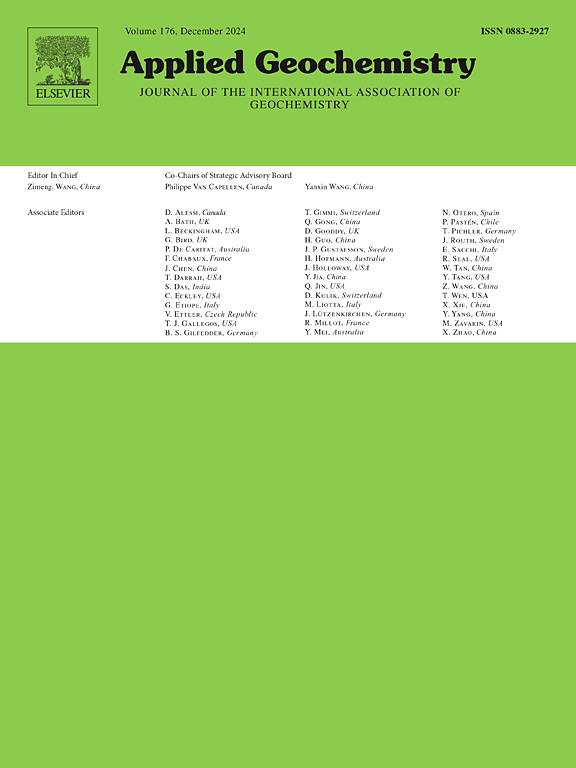The mobility of U(VI) associated with Fe(II)-induced transformation of schwertmannite and its reductive dissolution and re-precipitation in AMD environment
IF 3.4
3区 地球科学
Q1 GEOCHEMISTRY & GEOPHYSICS
引用次数: 0
Abstract
The formation and phase transformation of schwertmannite (Sch) in sulfate-rich AMD systems could significantly affect the migration and transformation of U(VI) via adsorption or co-precipitation. To explore this geochemical process, this study investigated the phase transformation of Sch and re-distribution behavior of U(VI) in simulated anaerobic AMD systems. The results demonstrated that Fe2+ had activated the adsorbed U(VI) through facilitating phase transformation. However, following activation by Fe2+, the residual U(VI) became more firmly bound to Sch than when extracted by hydrochloric acid, which could be attributed to a variety of mechanisms induced by Fe2+, including competitive adsorption on Sch and its reduction, dissolution and re-precipitation. Compared with Fe2+, pH plays a more auxiliary and enhanced role in the reduction and phase transformation of Sch. The X-ray photoelectron spectroscopy and XRD results revealed an increase in the pH-enhanced reduction of adsorbed U(VI) and structural Fe(III) by enhancing the adsorption capacity of Fe2+, bolstering solid–liquid electron transfer and promoting the reductive activity of the Fe2+ complexes formed on the Sch surface, thereby enhancing the reductive dissolution and re-precipitation of Sch coupled with competitive substitution of surface SO42− by enriched OH−.

cu (VI)的迁移率与Fe(II)诱导schwertmanite的转变及其在AMD环境中的还原溶解和再沉淀有关
富硫酸盐AMD体系中schwertmannite (Sch)的形成和相变可以通过吸附或共沉淀的方式显著影响U(VI)的迁移和转变。为了探索这一地球化学过程,本研究研究了模拟厌氧AMD系统中Sch的相变和U(VI)的再分配行为。结果表明,Fe2+通过促进相变活化了吸附的U(VI)。然而,经过Fe2+活化后,残留的U(VI)与Sch的结合比盐酸萃取时更加牢固,这可能是由于Fe2+诱导的多种机制,包括对Sch的竞争性吸附及其还原、溶解和再沉淀。与Fe2+相比,pH对Sch的还原和相变起着更辅助和增强的作用。x射线光电子能谱和XRD结果表明,pH增强了吸附U(VI)和结构Fe(III)的还原作用,这是通过增强Fe2+的吸附能力,促进固液电子转移和促进Sch表面形成的Fe2+配合物的还原活性来实现的。从而增强Sch的还原溶解和再沉淀,并与表面SO42−被富集的OH−竞争性取代。
本文章由计算机程序翻译,如有差异,请以英文原文为准。
求助全文
约1分钟内获得全文
求助全文
来源期刊

Applied Geochemistry
地学-地球化学与地球物理
CiteScore
6.10
自引率
8.80%
发文量
272
审稿时长
65 days
期刊介绍:
Applied Geochemistry is an international journal devoted to publication of original research papers, rapid research communications and selected review papers in geochemistry and urban geochemistry which have some practical application to an aspect of human endeavour, such as the preservation of the environment, health, waste disposal and the search for resources. Papers on applications of inorganic, organic and isotope geochemistry and geochemical processes are therefore welcome provided they meet the main criterion. Spatial and temporal monitoring case studies are only of interest to our international readership if they present new ideas of broad application.
Topics covered include: (1) Environmental geochemistry (including natural and anthropogenic aspects, and protection and remediation strategies); (2) Hydrogeochemistry (surface and groundwater); (3) Medical (urban) geochemistry; (4) The search for energy resources (in particular unconventional oil and gas or emerging metal resources); (5) Energy exploitation (in particular geothermal energy and CCS); (6) Upgrading of energy and mineral resources where there is a direct geochemical application; and (7) Waste disposal, including nuclear waste disposal.
 求助内容:
求助内容: 应助结果提醒方式:
应助结果提醒方式:


